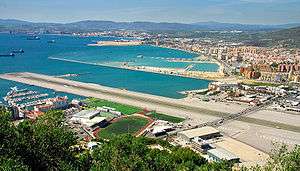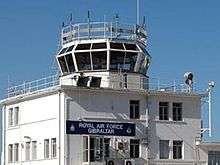RAF Gibraltar
| RAF Gibraltar | |||||||
|---|---|---|---|---|---|---|---|
 | |||||||
 LXGB Shown within Gibraltar | |||||||
| Coordinates | 36°08′58″N 005°20′50″W / 36.14944°N 5.34722°WCoordinates: 36°08′58″N 005°20′50″W / 36.14944°N 5.34722°W | ||||||
| Type | Royal Air Force station | ||||||
| Site information | |||||||
| Owner | Ministry of Defence | ||||||
| Operator | Royal Air Force | ||||||
| Site history | |||||||
| Built | 1942 | ||||||
| In use | 1942-Present | ||||||
| Battles/wars |
Second World War: Operation Torch Falklands War Gulf War Balkans Sierra Leone | ||||||
| Garrison information | |||||||
| Current commander | Wg Cdr Liz Hutchison RAF | ||||||
| Airfield information | |||||||
| Elevation | 3 metres (10 ft) AMSL | ||||||
| |||||||
Royal Air Force Gibraltar or more simply RAF Gibraltar, also formerly known as North Front, is a Royal Air Force station on Gibraltar. No military aircraft are currently stationed there, but RAF, Commonwealth and aircraft of other NATO nations will periodically arrive for transient stopovers, exercises, or other temporary duty. Administered by British Forces Gibraltar, the station is a joint civil-military facility that also functions as the Rock's civilian airport – Gibraltar Airport, with the civilian airport's passenger terminal building and apron facilities located on the north side of the runway while the apron and hangar of RAF Gibraltar are located on the south side of the runway.
History
A Royal Naval Air Service seaplane base was opened at Gibraltar during the First World War.[1]
The airport was constructed during World War II when Gibraltar was an important naval base for the British. Originally opened in 1939, it was only an emergency airfield for the Royal Navy's Fleet Air Arm. However, the runway was later extended by reclaiming some land from the Bay of Gibraltar using rock blasted from the Rock of Gibraltar while carrying out works on military tunnels. This last major extension of the runway allowed larger aircraft to land at Gibraltar. At this time the airfield completely obliterated the former Gibraltar horse racing track.
On 25 September 1939, No. 200 (Coastal) Group RAF was formed as a subordinate formation to HQ RAF Mediterranean in control of No. 202 Squadron RAF.[2] The Group's function was the control of Royal Air Force units operating from Gibraltar.[2] In late 1940 the Group was transferred to Coastal Command.[2] Later a joint RN/RAF Area Combined Headquarters was formed which commenced operations in early 1942.[3]
RAF North Front opened in 1942 and RAF New Camp opened around the same time.
The airfield played a major part in Operation Torch, the Anglo-American invasion of French North Africa (French colonial possessions in Algeria, Tunisia and Morocco) during the war.
Following the major reorganization of the Allied air forces at the Casablanca Conference in January 1943, RAF Gibraltar became a major sub-command of the Mediterranean Air Command under Air Chief Marshal Sir Arthur Tedder in February 1943.
On 29 May 1945 the Area Combined Headquarters was shut down and most of the personnel sent home.[4] Weather flights from Gibraltar were maintained at the end of the war by No. 520 Squadron RAF flying Halifaxes. This was superseded by a detachment of No. 518 Squadron RAF from Aldergrove, and then by the arrival of No. 224 Squadron RAF. Initially the squadron dispatched a detachment in May 1948, but the whole squadron moved to Gibraltar in August 1951.[5] It was re-equipped with Avro Shackletons. The station officially became "RAF Gibraltar" in 1966.
Units stationed
| RAF Units | Aircraft |
|---|---|
| No. 48 Squadron | Lockheed Hudson |
| No. 179 Squadron | Vickers Wellington |
| No. 202 Squadron | Consolidated Catalina |
| No. 210 Squadron | Catalina |
| No. 233 Squadron | Hudson |
| No. 248 Squadron Detachment | Bristol Beaufighter |
| No. 544 Squadron Detachment | Supermarine Spitfire |
| No. 813 Squadron, Fleet Air Arm | Fairey Swordfish |
| No. 1403 (Meteorological) Flight | Handley Page Hampden, Gloster Gladiator |
Anti-submarine warfare was a major priority of RAF Gibraltar during World War II and some of their aircraft were equipped with special detectors to locate German U-boats in the relatively shallow waters around Gibraltar. United States Navy Fleet Air Wing 15 based at Port Lyautey[7] coordinated its antisubmarine warfare operations with RAF Gibraltar and assigned a ZP-14 Squadron blimp pilot/liaison officer to Gibraltar.[8]
On 18 July 1944 the Commander of RAF Gibraltar, Air Vice-Marshal Alick Stevens, was introduced to the antisubmarine technology of a USN K-ship when ZP-14 Commander Emmett J. Sullivan took him for a short blimp ride. The Goodyear K-112 was the first K-ship to land in Europe earlier the same day.
The RAF camp, now known as Devil's Tower Camp, also hosted a number of small British Army units who performed various support roles from the camp over the years. There was 8 Surveillance Troop Royal Artillery who were responsible for (darkness hours) maritime radar security of the Rock during the border closure throughout the 70's and 80's. In addition to this there was also a Royal Engineers' Postal unit and a number of resident Infantry Battalion dog handlers - who were employed to supplement the RAF Police Dog Handling section. The accommodation block also provided facilities for a few members of the Royal Signals, WRAC and short stay transient visitors plus the occasional Royal Navy's Duty Frigate helicopter ground crews. The camp is now the Regimental Headquarters for the Royal Gibraltar Regiment - a unit of the British Army - consisting of both regulars and reservists and responsible for the local defense of the territory,

The airfield, which today is used mainly for civil flights, is unusual in that the main access road from Gibraltar to Spain crosses the airfield, necessitating the road to be closed whenever aircraft movements are in progress. When the RAF holds an exercise, this causes significant disruption to traffic flow. RAF Gibraltar used to have an Avro Vulcan K2 as a gate guard, but this was later scrapped due to its deterioration as a result of the high salt content in Gibraltar's atmosphere.
On 4 February 2011, The new RAF headquarters in Gibraltar was officially opened by The Chief of Joint Operations, Air Marshal Sir Stuart Peach.
'The Jaguar Building' is the result of several years of planning and follows the enhancement of transport links with Spain, which will include a tunnel at the eastern end of the runway. The latter however has been put on hold by the current administration of Gibraltar.
The old RAF site was needed for a new air terminal, so the Gibraltar Government agreed to pay for the new Headquarters and it was the perfect opportunity to put all sections under one roof.
Commanding officers
- Air Vice-Marshal Sturley Simpson - AOC, AHQ Gibraltar December 1941 to Feb 1944
- Air Vice Marshal William Elliot - AOC, RAF Gibraltar Feb 1944 to June 1944
- Air Vice Marshal Alick Stevens - AOC, RAF Gibraltar June 1944 - August 1945
- Air Commodore Richard Jordan - During 1948.
- Wing Commander Simon Dowling - During 2011.
- Wing Commander James Holland - During 2015.
- Wing Commander Liz Hutchison - During 2016
Gibraltar squadrons
- No. 202 Squadron RAF
- No. 224 Squadron RAF (Disbanded)
Gallery
 The modern day control tower of RAF Gibraltar/Gibraltar Airport
The modern day control tower of RAF Gibraltar/Gibraltar Airport The runway of RAF Gibraltar/Gibraltar Airport looking from East to West
The runway of RAF Gibraltar/Gibraltar Airport looking from East to West.png) A Lockheed Hudson of No. 233 Squadron RAF leaves its dispersal at Gibraltar for a reconnaissance sortie, in August 1942.
A Lockheed Hudson of No. 233 Squadron RAF leaves its dispersal at Gibraltar for a reconnaissance sortie, in August 1942. Goodyear ZNP-K ships of United States Navy Blimp Squadron ZP-14 coordinated their anti-submarine warfare operations with RAF Gibraltar in 1944.
Goodyear ZNP-K ships of United States Navy Blimp Squadron ZP-14 coordinated their anti-submarine warfare operations with RAF Gibraltar in 1944.
Panoramic view

References
- ↑ Air of Authority - A History of RAF Organisation - RAF Stations
- 1 2 3 "Air of Authority—A History of RAF Organisation". Royal Air Force Organisation. Retrieved 2007-07-04.
- ↑ "The History of RAF Gibraltar". Royal Air Force—Gibraltar. Retrieved 2007-07-05.
- ↑ Lee, 1989, 197.
- ↑ Lee, Wings in the Sun, 1989, 197, 198.
- ↑ Richards, D. and H. Saunders, The Royal Air Force 1939-1945 (Volume 2, HMSO, 1953)
- ↑ Blimp Squadron 14: Craw Field, Port Lyautey, French Morocco
- ↑ Blimp Squadron 14: First transatlantic crossing by non-rigid airships
External links
| Wikimedia Commons has media related to RAF Gibraltar. |
- Airport information for LXGB at World Aero Data. Data current as of October 2006.
- Royal Air Force - RAF Gibraltar
- RAF Gibraltar at RAF Web
- Crest Badge and Information of RAF Gibraltar
- James Rogers and Luis Simón. The Status and Location of the Military Installations of the Member States of the European Union and Their Potential Role for the European Security and Defence Policy (ESDP). Brussels: European Parliament, 2009. 25 pp.
